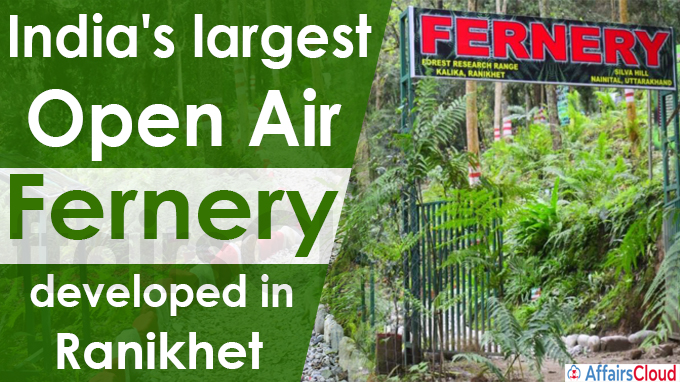
India’s largest Open-air Fernery, consisting 120 different varieties of ferns, was inaugurated by the famous expert on Pteridophyte (Ferns), Dr Nilambar Kunetha in Ranikhet, Uttrakhand.However, it is the country’s first open-air fernery in natural surroundings which is not under any poly-house/ shade house.
- The fernery has the largest collection of fern species, second to only Jawaharlal Nehru Tropical Botanical Garden and Research Institute (TBGRI), Thiruvananthapuram, Kerala.
Objective–
To conserve and protect various ferns and species and to spread awareness about its ecological values.
About the Ranikhet Fernery-
i.It was developed by the research wing of Uttarakhand Forest Department, under Central Government’s Compensatory Afforestation Fund Management and Planning Authority (CAMPA) scheme. It takes 3 years to complete.
ii.The fernery is spread around an area of 4 acres at an altitude 1800m.
iii.It consists of a mixture of species from western and eastern Himalayan region.
Threatened Species-
Some rare species such as Tree Fern (Cyathea spinulosa), which has been declared as threatened by the State Biodiversity Board of Uttarakhand. Only a few plants of this species have been left in the wild and it is considered to be one of the most ancient species of fern. It is believed that herbivore dinosaurs used to feed on its trunk as it is starch rich.
iv.It has around 30 species of high medicinal importance such as Hansraj(Adiantum venustum). The herb Hansraj has an important role in Ayurveda and Tibetan medicine. Therefore it has a high value to cure several diseases.
v.Some edible species, fern-like Lingura( Diplazium esculentum). It’s a nutritional vegetable found in Uttarakhand.
vi.The fernery also has the rich collection of species like epiphyte, aquatic ferns, and the more popular and interesting ferns like Vishkanya, Mayur Shikha, Boston fern, Lady Fern, Rock Fern, Basket Fern, Ladder fern, Golden fern and Horse-tail fern.
What are ferns?
- Ferns are non-flowering pteridophytes.They belong to one of the ancient groups of plants that propagate through spores. They are the first plants to have a fully developed vascular system.
- They help in filtering heavy metals from polluted water and the nitrogen fixation process.
About Compensatory Afforestation Funds Management and Planning Authority (CAMPA)
The Ministry of Environment and Forests (MoEF) was introduced in 2004 to accelerate activities for the preservation of natural forests, management of wildlife, infrastructure development in forests, and other allied works.




